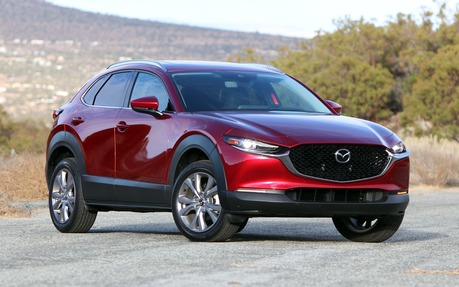2020 Mazda CX-30: CrossMazda3
Mazda is introducing a fourth crossover for 2020, meaning cars will soon become a minority in the brand’s lineup.
Slotting between the CX-3 and CX-5, the all-new Mazda CX-30 won’t replace the former—at least not for now. The idea is to keep the CX-3 around for a while to offer budget-minded consumers a cheap alternative. But given the lack of success of this model in North America (only 19,000 units were sold in the U.S. last year versus 12,500 in Canada), you can be sure a second generation is not part of the plan.
While living on borrowed time, the CX-3 will help Mazda make the transition to the more upscale CX-30, which reflects the extremely impressive levels of refinement, luxury and build quality achieved by recent Mazda products.

The Adventurous Mazda3?
The CX-3 is derived from the Mazda2 (currently rebadged and sold in Canada as the Toyota Yaris), but the new CX-30 shares its platform and powertrains with the Mazda3. Heck, even the dashboard is nearly identical. This small SUV is to the Subaru Crosstrek what the Mazda3 is to the Subaru Impreza, except that it features unique styling.
Sales of the new Mazda3 are significantly down and this is attributable in large part to waning interest in traditional cars, even though it now offers an AWD option. By adding the CX-30, Mazda hopes to boost sales and we wouldn’t be surprised at all if it becomes more popular than the compact sedan in a few years.
As a volume-seeking product, the CX-30 comes with the same three trim levels as the Mazda3: GX, GS and GT. A top-line Signature model has not been announced yet, but clearly it’s on the table.
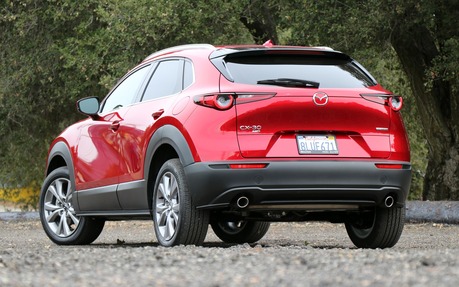
Fresh New Looks
A bold yet understated nose—the complete opposite of a Lexus NX—defines the look of the 2020 Mazda CX-30. Contrasting body cladding on the wheel arches and lower panels give it a muscular stance, while the rest of the silhouette is downright sexy.
For more convenience, the cargo floor is lower than that of the CX-3 and the 50-mm wider trunk puts the CX-30 on par with the average competitor. It may not be the most spacious in the segment, but at least now you won’t be penalized for choosing Mazda over a Hyundai Kona or Nissan Qashqai.
When you sit behind the wheel, this vehicle feels luxurious just like the Mazda3. Granted, we tested a fully equipped GT model, but even the lower trims stand way above average in terms of fit and finish. The seats are beautifully sculpted, the driving position is perfect and every touch point is memorable. Designers paid special attention to the tactility of the various buttons and controls to create a pleasant experience that inspires confidence.
The lack of squeaking and cracking noises is the result of premium material selection and careful assembly, not to mention that there is no panoramic sunroof for maximum structural rigidity.
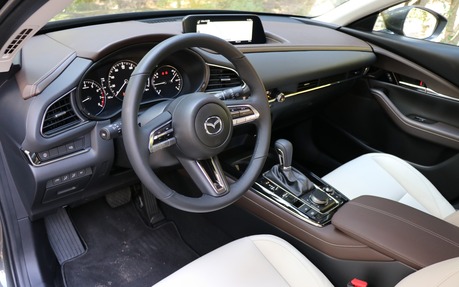
Fully Loaded
Equipped with a superb Bose sound system, magnificent leather upholstery and heated and ventilated seats, the Mazda CX-30 compares favourably with much more expensive rivals like the Mercedes-Benz GLA, for example. In GT trim, you also get a head-up display, heated steering wheel, memory seating, automatic high beams and navigation to go along with Apple CarPlay and Android Auto.
Of course, the volume seller will be the mid-range GS, which is generously equipped, too. But there’s no denying that Mazda is pushing upmarket and targeting more discerning customers.
Why does Mazda stick to a rotary controller on the centre console? Because designers will tell you a touchscreen with all sorts of apps and menus is more distracting on the road. They believe their current setup, which offers a simple interface with user-friendly menus, is the best way to go. Admittedly, it works like a charm, except when you want to search for a radio station. Also, the amount of space left on the console is fairly limited.
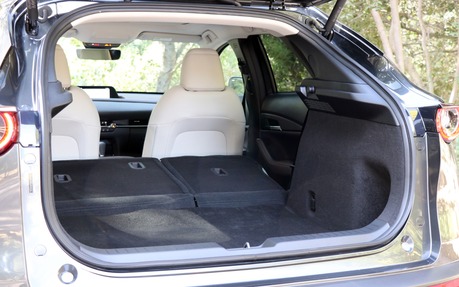
More Energy Under the Hood
The base GX model uses a 2.0-litre engine rated at 155 horsepower and mated to a six-speed automatic transmission. All-wheel drive is optional—and quite effective at improving handling, we must say. If you try a GS or GT, you’ll fall in love with the spirited 2.5-litre mill that produces 187 horsepower, enough to put every competitor to shame save for the Kona 1.6T.
It goes without saying that the bigger powertrain combined with AWD requires a bit more fuel at the pump. Average consumption is rated at 8.5-9.0 L/100 km. You should know that the GT features cylinder deactivation technology for slight gas savings under light load.
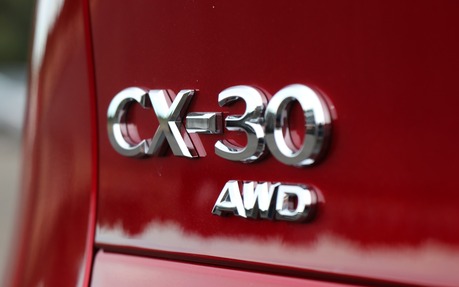
Taking on the Germans
While driving the Mazda CX-30, I kept wondering what it would be like with the turbocharged 2.5-litre engine found in the Mazda6 and CX-9. I’m not saying the GT lacks power, but a future Signature model equipped with a powerplant like that would seriously challenge small luxury SUVs from Germany, more specifically the Audi Q3, BMW X1/X2 and the aforementioned GLA. Even with a price bump to around $38,000, the CX-30 would be $10k-$15k cheaper than these revered nameplates. Sure, the Mazda logo doesn’t carry the same prestige as the four rings or silver star, but other than that, you wouldn’t miss a thing.
The CX-30 is a joy to drive. The stiff chassis and nicely calibrated suspension allow full control of the vehicle and the road, while the remarkably sharp steering ensures plenty of fun (only the BMW X1 and X2 score more points in that department). Mazda engineers also focused on noise insulation. You can still hear the distinctive sound of the 2.5-litre engine under acceleration, but at cruising speed the ride is exceptionally quiet. In fact, Mazda claims the CX-30 is even quieter than the CX-5.
Braking is much better than with the CX-3, as well, both in terms of pedal feel and stopping distances. The only problem here might be durability, as evidenced by the number of new Mazda3 owners who have had to replace brake components already. Is Mazda’s G-Vectoring Control system to blame? As previously explained, this feature enhances handling and stability and reduces the need for the driver to depress the brake pedal by automatically slowing the inside wheel in corners. One thing is for sure: the CX-30’s braking is very effective, unlike many Mazdas in the past.
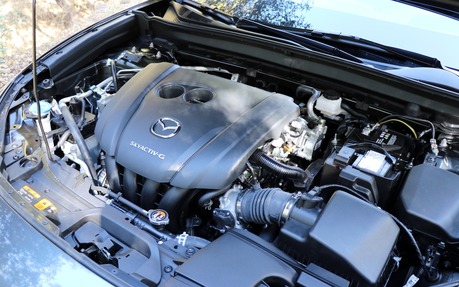
A Tough Fight Ahead
Things are heating up quite a bit in the small-SUV segment—more so than in the compact-car segment. Every manufacturer offers at least one and many have two. And pretty soon Volkswagen will replace the Golf SportWagen with a new model positioned below the Tiguan.
Where does the Mazda CX-30 rank? It is certainly good enough to step on the podium alongside the Kona and Crosstrek. These three are followed closely by the Honda HR-V and Nissan Qashqai, two slightly older models that remain quite interesting. Also, keep an eye on the upcoming Kia Seltos, which shares many components with the Kona.
Mazda has a good one-two punch with the affordable CX-3 and the more modern, more upscale CX-30. By the way, why is the latter named CX-30 and not CX-4? Simply because a Mazda CX-4 is already sold in China.
| Test drive report | |
| Test model | 2020 Mazda CX-30 |
|---|---|
| Trim level | GT |
| Price range | $23,950 – $33,850 |
| Price as tested | 33 850 $ |
| Warranty (basic) | 3 years/unlimited |
| Warranty (powertrain) | 5 years/100,000 km |
| Fuel economy (city/highway/observed) | 9,5 / 7,4 / N/A L/100km |
| Options | N/A |
| Competitive models | Buick Encore, Buick Encore GX, Fiat 500X, Ford EcoSport, Honda HR-V, Hyundai Kona, Kia Seltos, Mitsubishi RVR, Nissan Qashqai, Subaru Crosstrek |
| Strong points |
|
| Weak points |
|
| Editor's rating | |
| Fuel economy | The CX-30 has above-average power and below-average fuel economy, even with available cylinder deactivation technology. |
| Comfort | The cabin is much quieter and has more comfortable seats than that of the CX-3. |
| Performance | On-road performance and acceleration are surprisingly good. Imagine what it would be like with a turbo engine! |
| Infotainment | The interface requires some getting used to, but the infotainment system is much more user-friendly than before. |
| Driving | This is where the CX-30 has a big edge over the competition. |
| Overall | The new Mazda CX-30 is certainly good enough to rank in the top three. |
